I keep meaning to post reviews about my gear. I’ve been lucky enough to shoot years with some of the best lenses in the world. I hold strong opinions on them and rarely does that opinion make it beyond my own inner dialogue.
This time I’m doing it right away. This morning, March 3rd, 2015, I got that ever exciting knock on the door from my Fed-Ex guy. In his hands was a much bigger box than I had envisioned. What lies within it is Canon’s newest drool-worthy lens, the 11-24mm F4L.
Quick note: I’m not here to give you the exact technical run down. I’m going to tell you what my thoughts as a working professional are on this lens. I will interject my opinions on when to use it and how I see myself using it here forth. If you’re looking for MTF charts and barrel distortion tests, you won’t find it here. If you want to see REAL LIFE examples when using this lens compared to the Canon 14mm F2.8L and the 24mm F1.4L, you’re right at home, read on.
Immediately, I was stunned by the sheer size of the box. There’s no way a lens with a maximum focal length of 24mm’s could take up this big of a box… right?
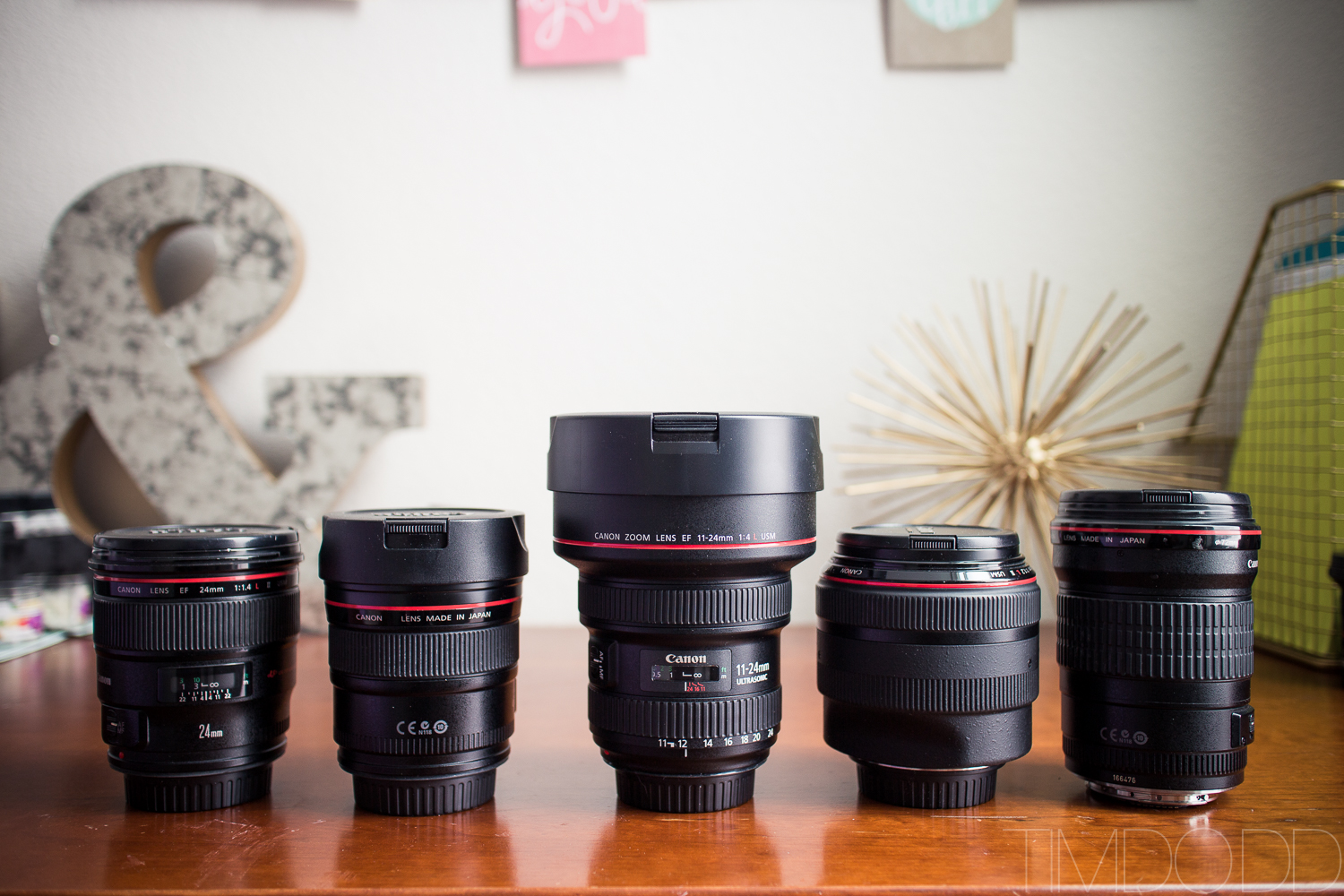
(Left to right) Canon 24mm F1.4L, Canon 14mm F2.8L, Canon 11-24 F4L, Canon 85mm F1.2L, Canon 135mm F2.0L
Woah. Holy Cow. Ok, it IS that big.
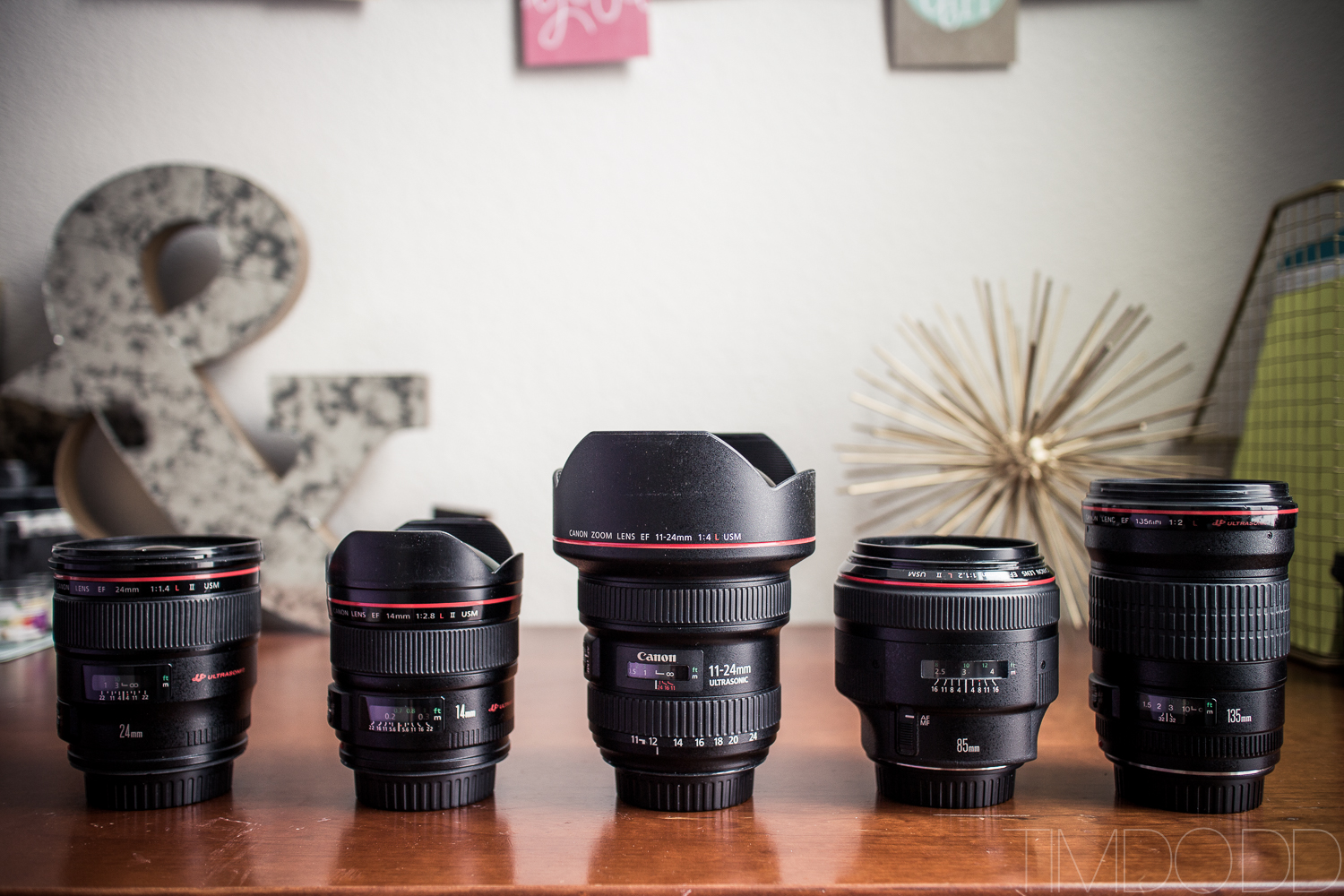
(Left to right) Canon 24mm F1.4L, Canon 14mm F2.8L, Canon 11-24 F4L, Canon 85mm F1.2L, Canon 135mm F2.0L
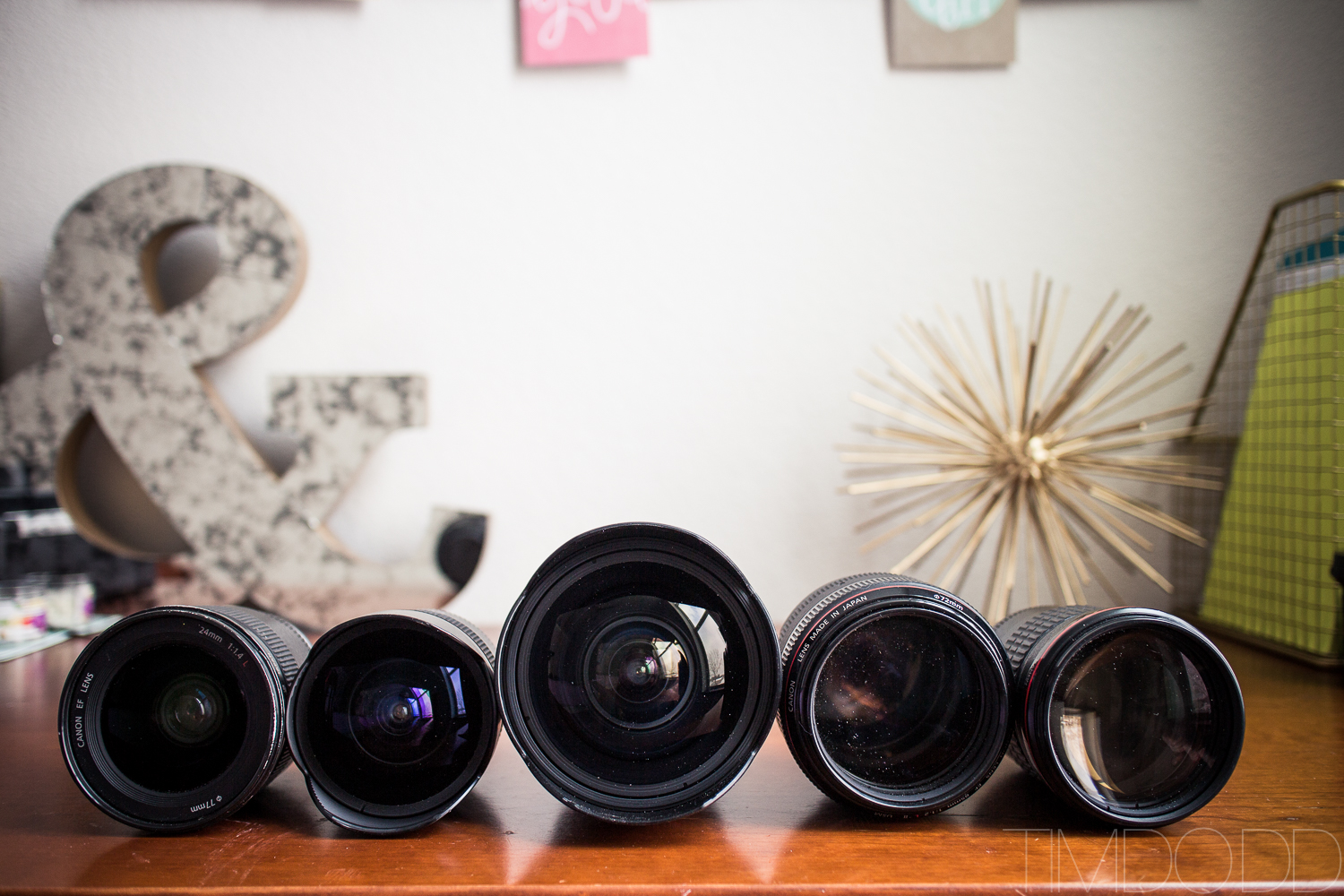
(Left to right) Canon 24mm F1.4L, Canon 14mm F2.8L, Canon 11-24 F4L, Canon 85mm F1.2L, Canon 135mm F2.0L
Lo and behold this thing is just simply a beast. It dwarfs other L lenses of similar focal length in both weight and overall size. According to Canon, the weight is 2.6 pounds (1.18 Kg). That is almost double the weight of the Canon 14mm F2.8L, which weighs in at 1.42 (645 grams). As a matter of fact, it weighs nearly the same as the two lenses I was hoping to replace in my bag when doing travel photography, the 14mm F2.8L and the 24mm F1.4L.
About that weight and size, it feels great. My 5D MK III feels well weighted and the lens fits great in your hands. It’s a little more front heavy than you’d expect, probably due to that massive front element.
The rear element supports drop in gel filters. This is due to the large and odd shape of the front element.
Putting the 11-24 on a Canon EOS M is a hilarious proposition. As you can see in the above picture, the 14mm (which used to look huge) now looks comically small. The 11-24 feels proportional (although massive) on the 5D MK III but it looks downright silly on the EOS M.
The zoom ring and focus ring are EXTRA tight, which I LOVE. Knowing how the tightness wears out after a few years of good use, the tighter it is day 1, the better for me. It leads to easy liveview focusing when you’re trotting around trying to dial in focus perfectly.
Autofocus is your typical Ultrasonic motor fast. Nothing extra spectacular here, but first impressions it seems to nail focus much more accurately than the 14mm F2.8L, which you’ll see in a few upcoming examples.
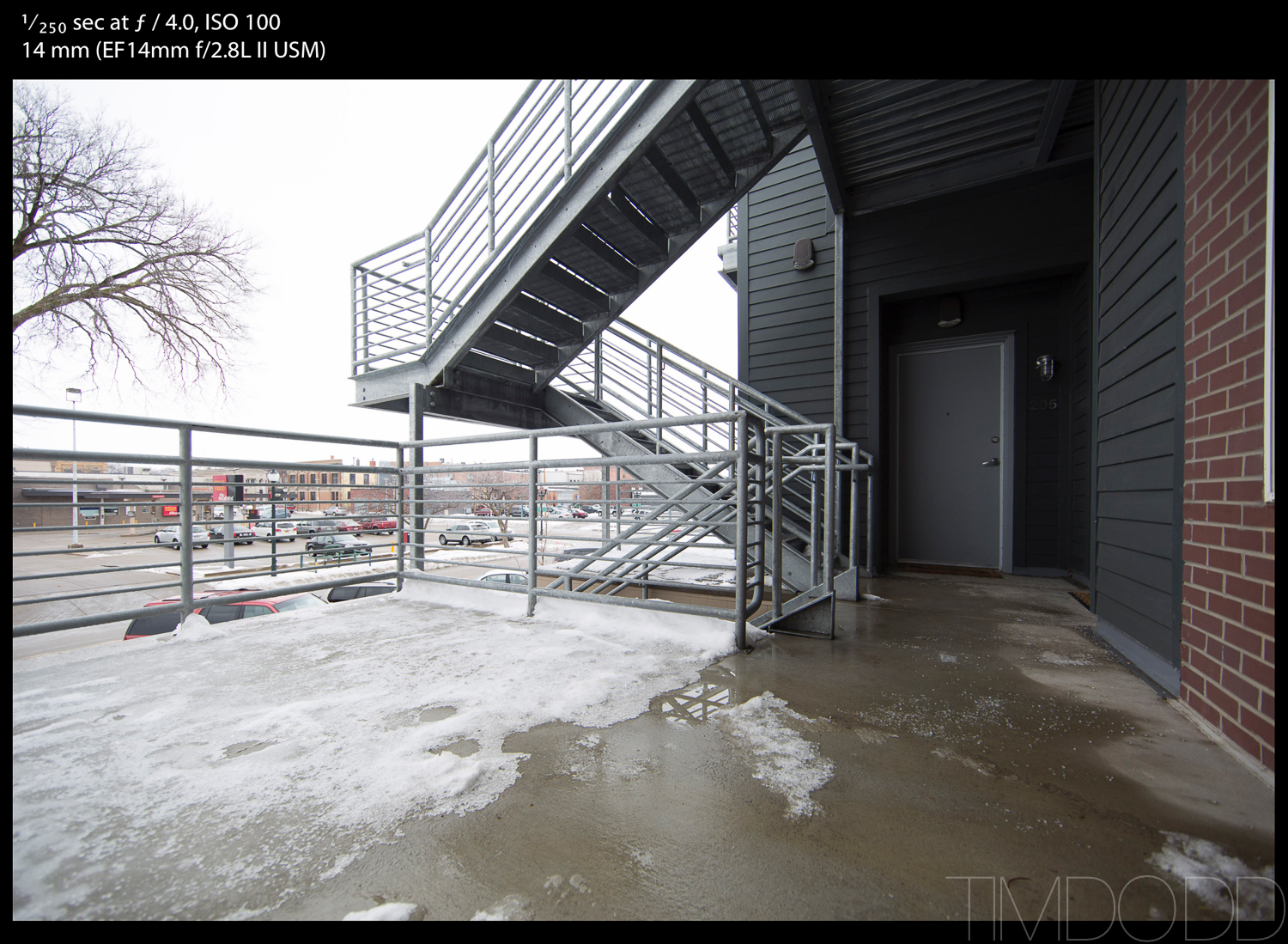
So we’ll start off with my previous go-to for ultra wide angle lenses, the 14mm F2.8L. (Click for a full resolution JPEG)
So what’s 14mm actually look like compared to 11mm? Let’s see…
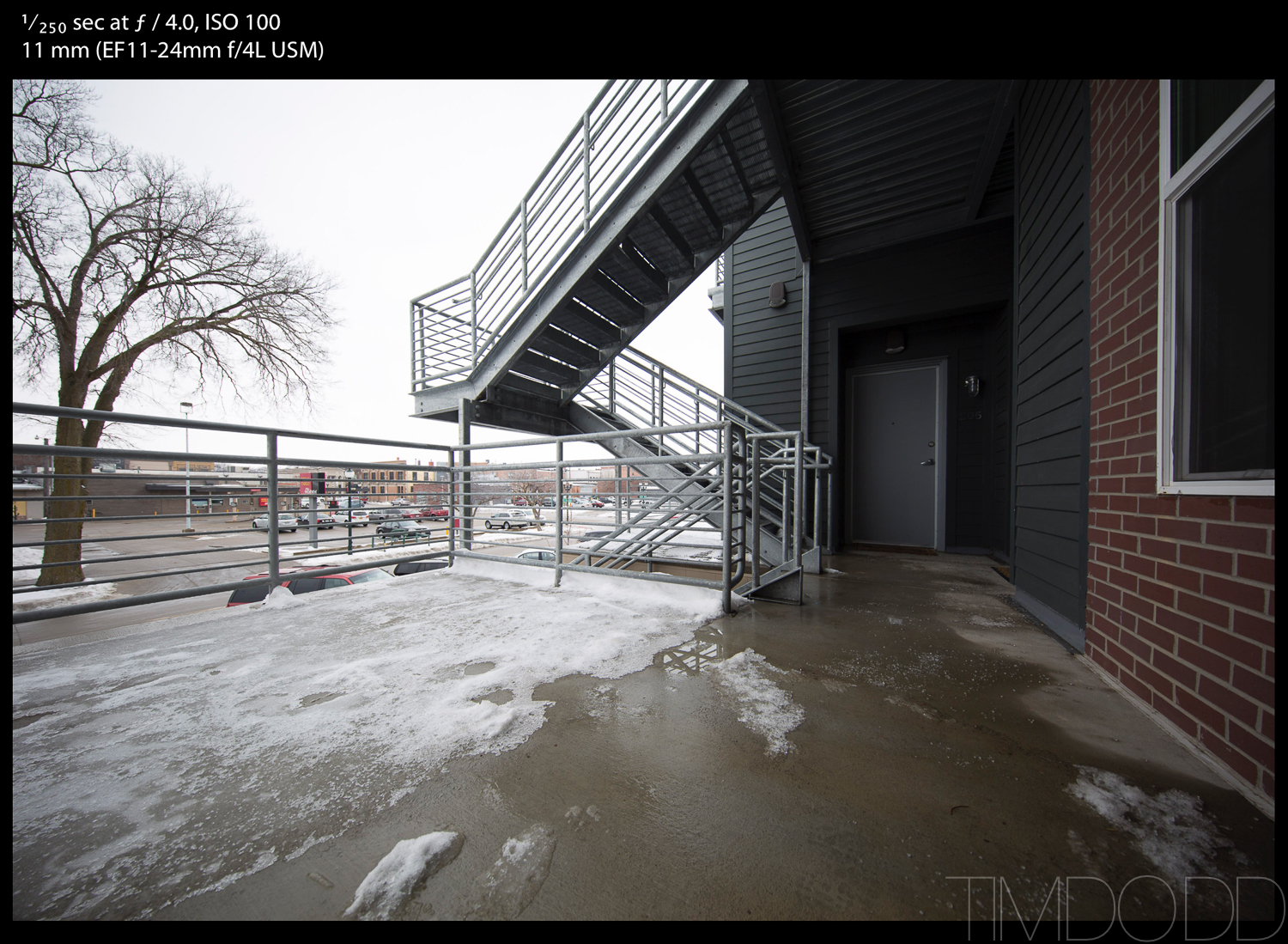
Woah. 11mm’s on a full frame is pretty crazy. I know this looks like a large patio area, but it’s truly not a large space. Notice, there does appear to be a little extra lens vignette compared to the 14mm. That’s easy to fix though. (Click for a full resolution JPEG)
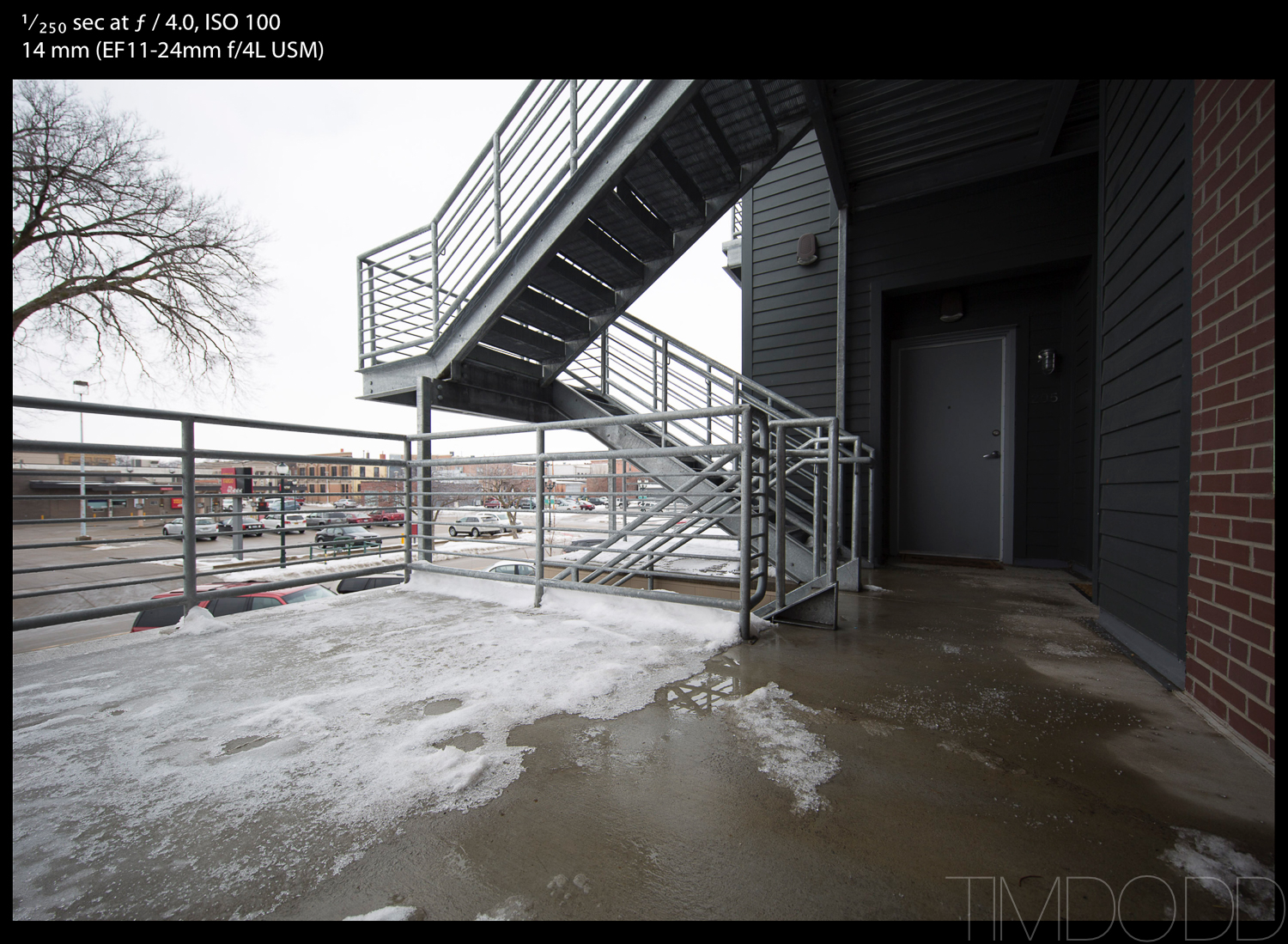
The 11-24 appears to do a better job of controlling chromatic aberration than the 14mm. The tree appears to have retained a little better detail, but let’s get in closer to see if that holds true. (Click for full resolution JPEG)
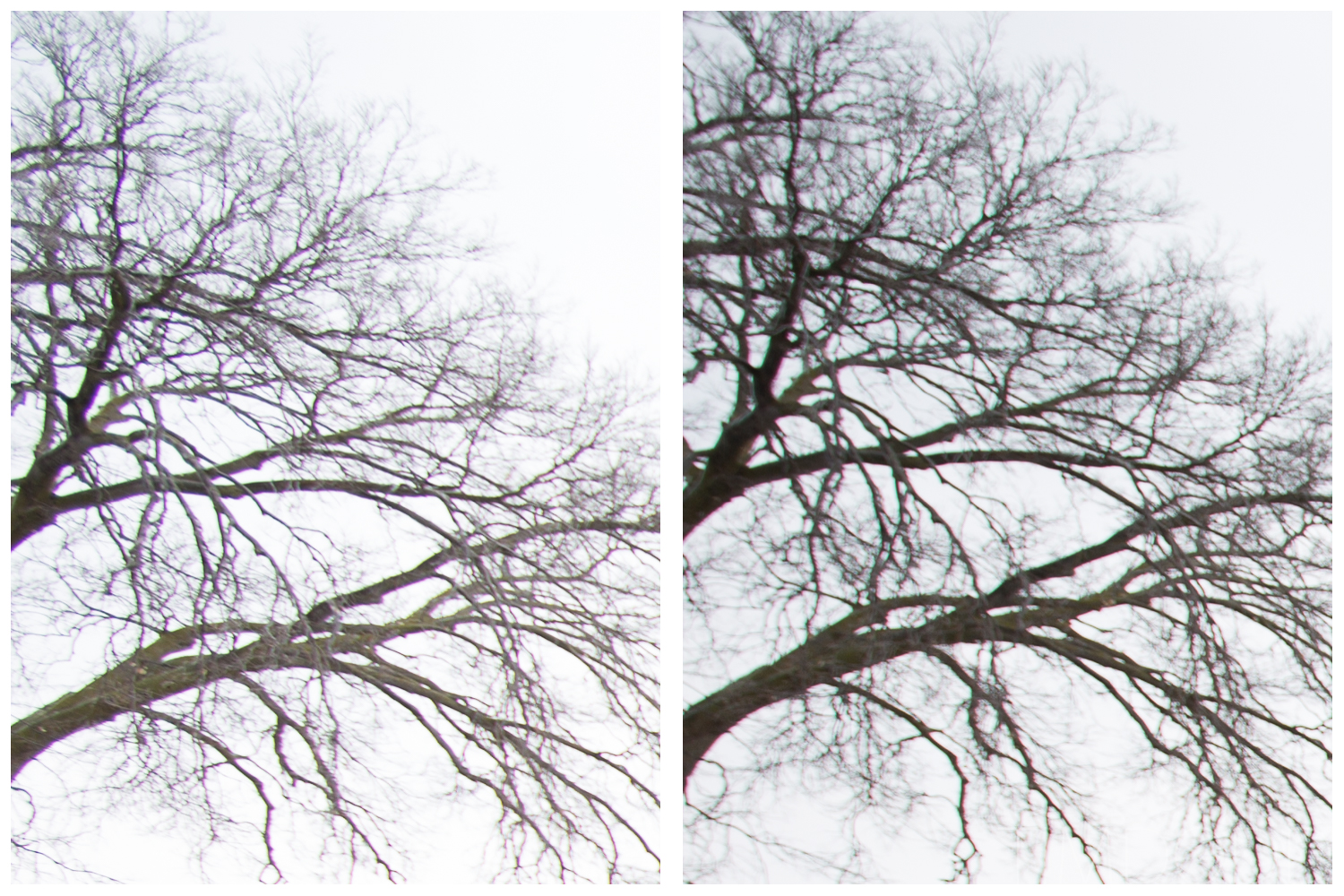
(LEFT) 14mm F2.8L vs (RIGHT) 11-24mm F4L So, on closer inspection, the 14mm seems to be much sharper, but the 11-24 has less pink fringing. This is a tight crop of the very top left corner of the lens.
So, the 14mm appears to out resolve the 11-24mm in the corners, but how about the center? To be honest, this could’ve been down to my manual focus abilities in liveview. Regardless, let’s peek at the center.
Again, to be honest, this could be down to my manual focus abilities, but they both appear pretty excellent in the center. The 11-24 does an excellent job of controlling fringing/chromatic aberration. You can clearly see in the railings against the white sky a lack of any additional color on the edges.
What about compared to my truest work horse, the 24mm F1.4L II? It can’t possibly hold up against one of Canon’s sharpest lenses, can it?
Before we move onto the crops of these two photos, notice the 24mm F1.4L appears to have a little more barrel distortion compared to the 11-24. I’m very surprised by this. Canon seems to have tamed the distortion very well on the zoom.

(LEFT) 11-24mm F4L vs (RIGHT) 24mm F1.4L Notice the exposure difference. Although I took these pictures back to back, I think the vignette of the 11-24 makes the stairs appear to have a little more contrast. Sharpness is on par with the Canon’s sharpest wide prime.
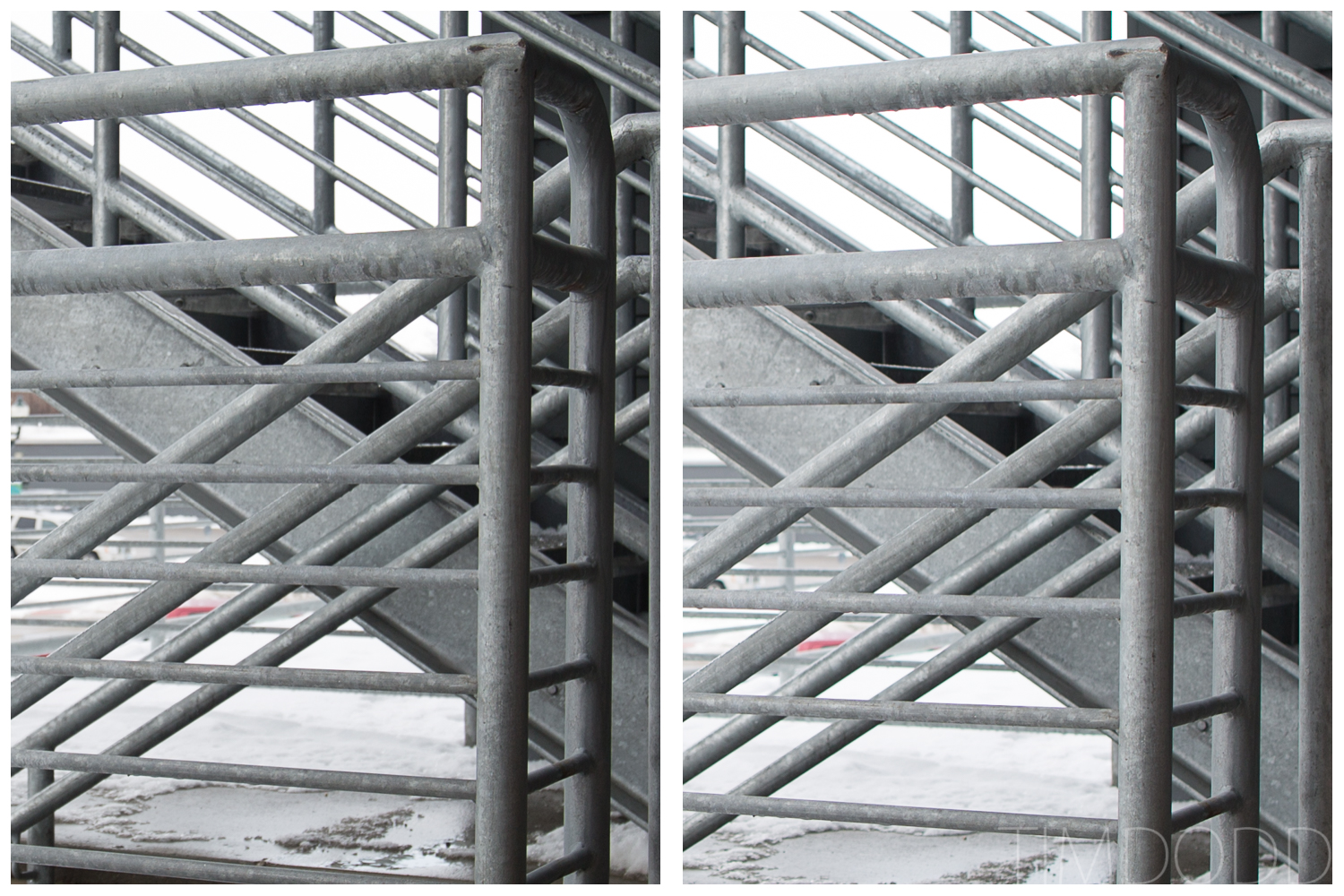
(LEFT) 11-24mm F4L vs (RIGHT) 24mm F1.4L Again, the exposures seem a little different (although they weren’t), lighting could have changed a bit between the two minutes as clouds were moving fairly quickly. But again, the 11-24 appears to have a little more contrast. Again, detail is on par. Considering the 11-24 is shooting wide open (F4), this is impressive.
So, it seems to really fare well against two of Canon’s best wide angle primes, the 24mm F1.4L II and the 14mm F2.8L II. This is important when I consider packing a bag for two weeks of travel in Europe. My biggest fear would be compromising image quality for an all-in-one solution. When I’m doing travel photography, F stop is less relevant than in portrait/event photography. I use a tripod often, and I can hold the shutter open long enough that the F4 doesn’t faze me as much. Knowing the extra “legs” the lens has with its 11mm focal length is worth the drops in F stops. It’s something I can’t achieve elsewhere.
Notice the 11mm is so wide it’s even getting the edge of the building I’m standing NEXT to! I did not expect to see that building in my shot. It’s insanely wide. So wide, it will be impossible to get people out of your shot sometimes.
Due to the cloud movement, we have to ignore exposure a little bit. BUT, the 11mm still appears to have a decent amount of vignetting visible. Luckily for us, vignetting is easy to fix, and sometimes even a little desirable. Once Canon has a lens profile for this lens, they’ll be able to fix the inherent vignette so you don’t have to even worry about it in post.
Another side note is all of these shots were using autofocus on the same point (just above the center). This was to show how accurate the autofocus was right out of the box. I’ve tried to dial in the 14mm F2.8L II many times and have always struggled with beyond 20 feet accuracy. It looks like the 11-24 hit focus much better than the 14mm.
(Update: 4/15/2015) After a few months of shooting with the 11-24, I can confirm at F4 it has pretty severe vignetting at 11mm. Again, lucky for us, vignetting is very easy to fix. See below examples:
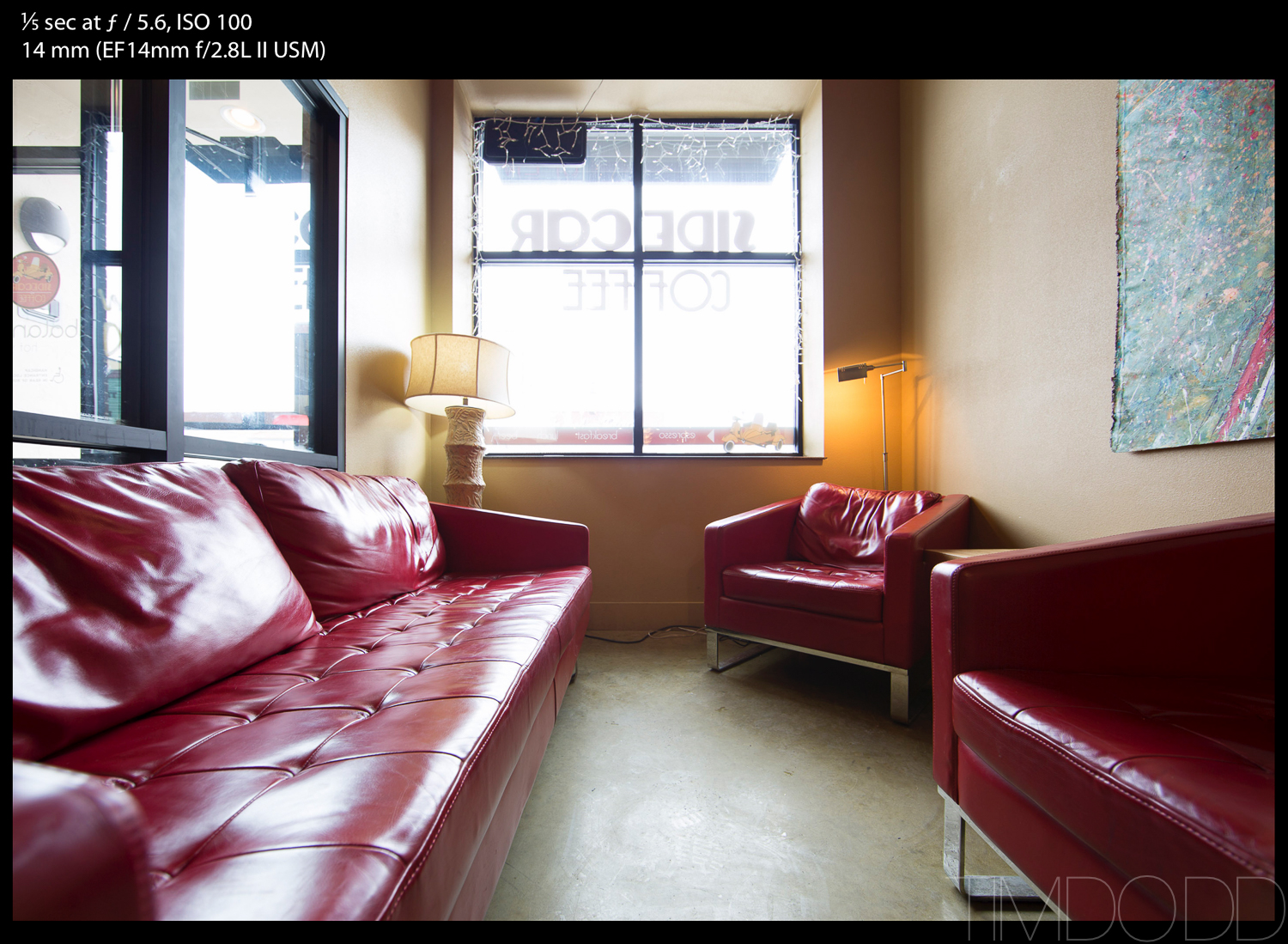
I do a decent amount of real estate pictures for local realtors. This would be a fairly typical shot with my old 14mm. Size matters and every realtor and their clients want the inside of their house to look as big as possible. Look how big this room looks when we go from 14mm to 11mm. (Click for full resolution JPEG)
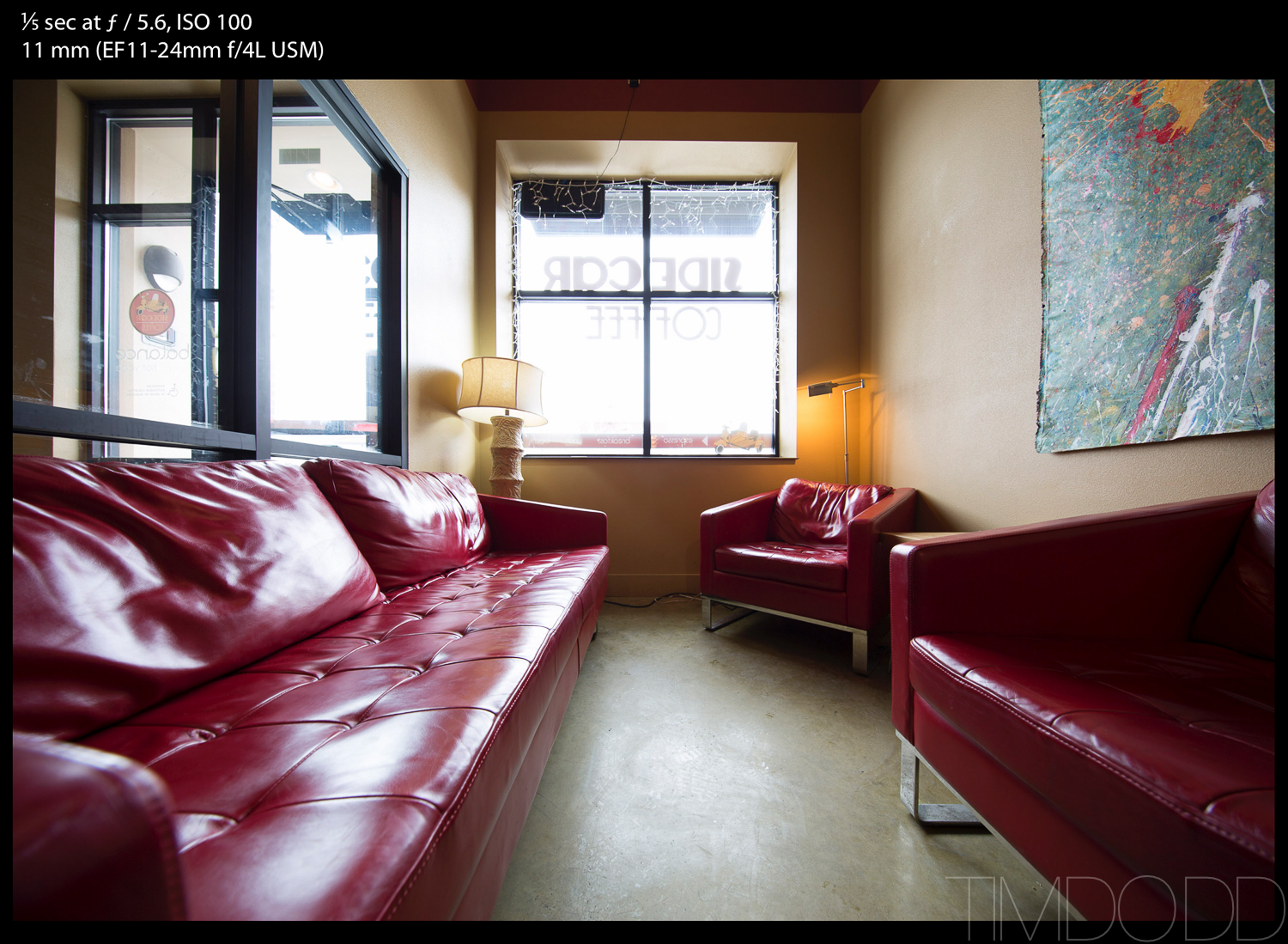
The room appears to have grown a few feet back. It doesn’t appear much wider, but we have magically made it appear much larger. This is the ultimate for indoor spaces. This would certainly be the best lens available for shooting houses. Realtors, either fork up the $3,000 for this lens and another $2000 for a full frame camera to utilize it, or hire someone who has it. Use it right and you’ll be able to sell houses like none other. (Click for full resolution JPEG)
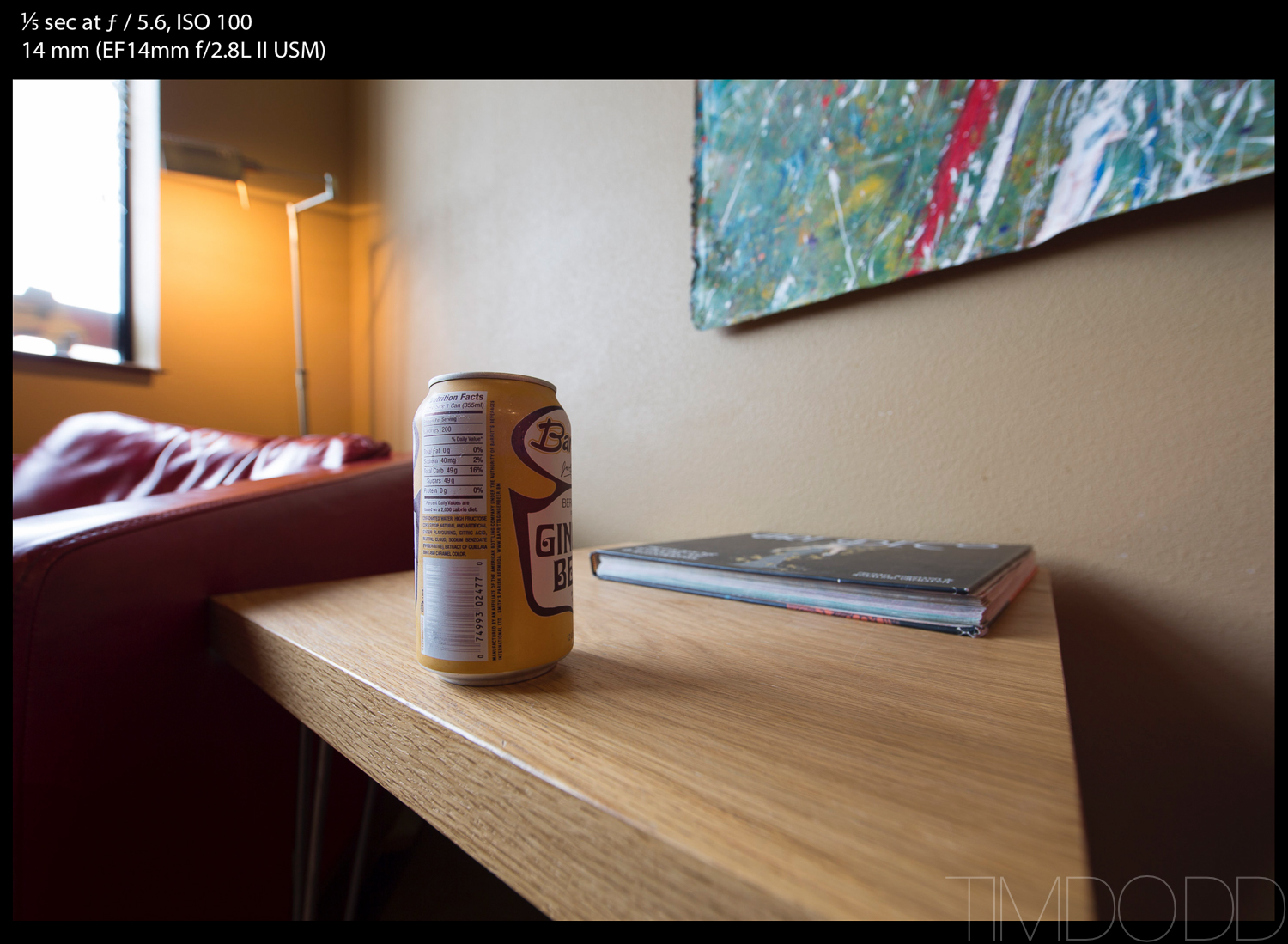
Here’s a case of how we can use wide angles wrong. This table is perfectly square, but having shot it at an off angle it appears to be a strange polygon.
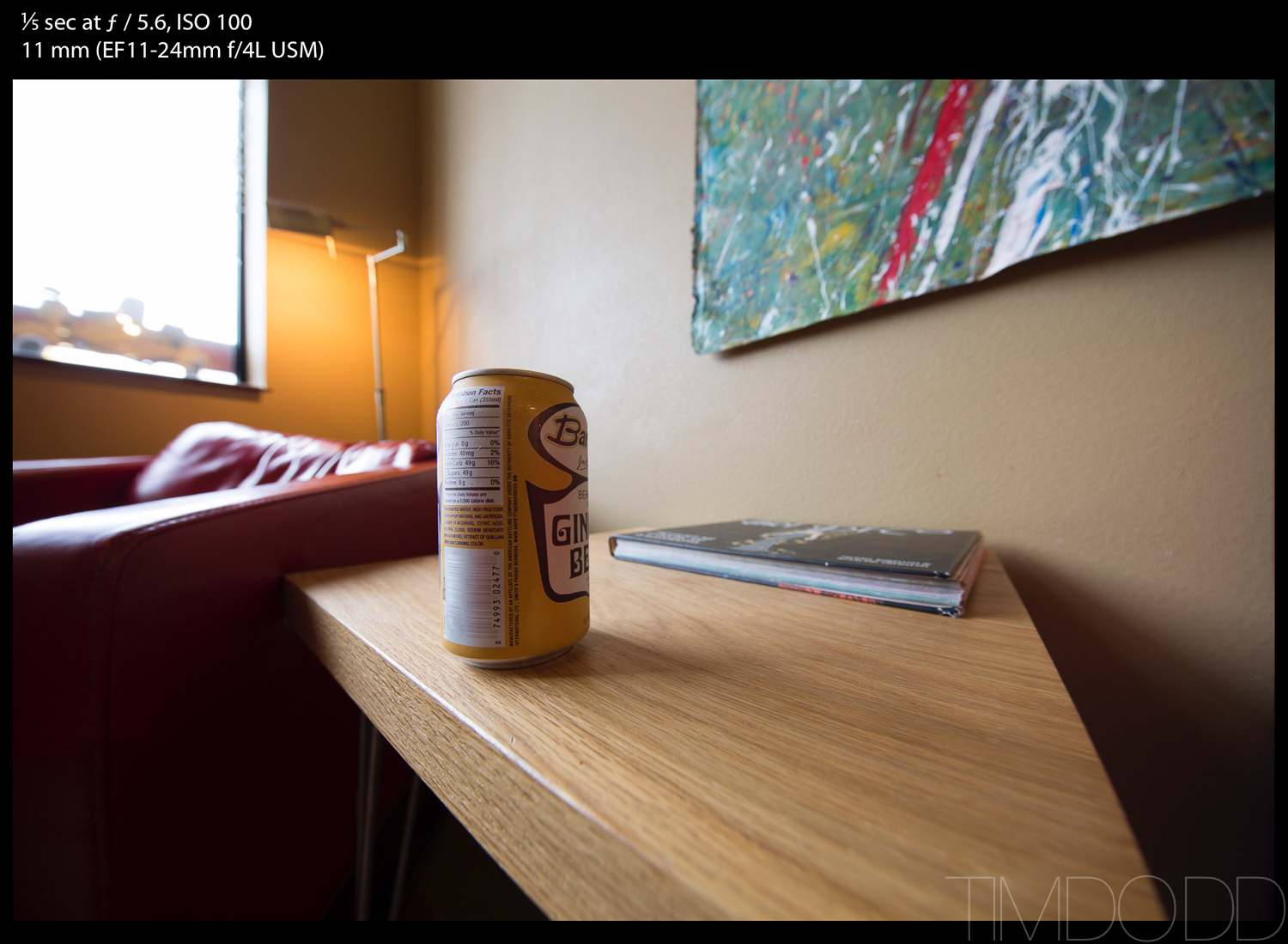
To make that effect even worse, here it is at 11mm. The square table is almost un recognizable as a square. Make sure and line up your shots to keep lines square with each other, so as not to completely confuse the viewer. Shooting pleasant shots with a wide angle is actually very difficult.

It’s hard to express how close the camera was to the soda can, so here’s a shot with my iPhone. Not at all what it looked like in the shots, right?
So to sum up: Canon has produced a lens that’s as sharp or sharper than its prime counterparts. Although slower (F stop wise). It has chromatic aberration and distortion well under control. Vignetting is probably its biggest fault. But, that’s probably the easiest thing to have fixed in post, so I’m not shaken by that.
It’s a heavy, big lens that might be intimidating to some. It’s very front heavy–so heavy in fact it fell out of my shoulder bag already…
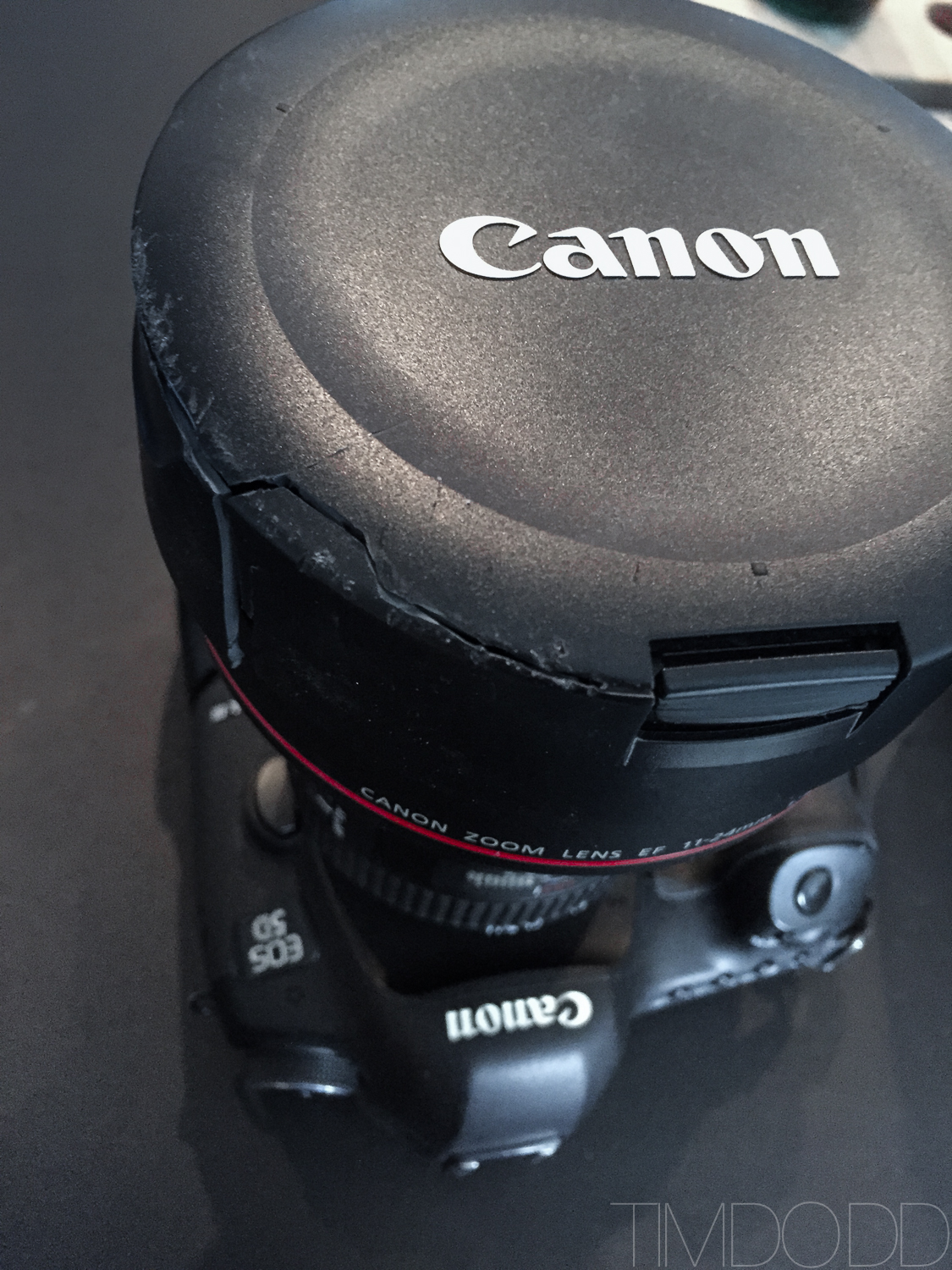 Luckily the replacement lens cap is only $25, but it’s currently unavailable. *Face in palm*
Luckily the replacement lens cap is only $25, but it’s currently unavailable. *Face in palm*
I’ll be using this lens primarily for architectural and real estate shoots. It’ll also be a travel companion, although I don’t use wide angle lenses for my landscape shots. It also won’t replace my 24mm F1.4L for weddings and events because I need the additional brightness of the prime. There’s just too many times that I’m hand holding at F1.4, ISO 3200, 1/50th of a second and I have NO room for a slower F stop, let alone a lens that lets in 8 times less light.
In case you don’t know how the F-stop scale works, going from F1.4 to F2.0 is half as much light. From F2.0 to F2.8 is another half, and again going from F2.8 to F4.0. So again, I won’t be replacing my F1.4 with an F4 any time soon. But going out to 11mm is unheard of, and because of that, it will have a place in my bag.
Make sure and follow me on Instagram @timdoddphotography and @everydayastronaut
Let me know if you’d like me to do a review on anything else you see in my gear bag on Instagram.
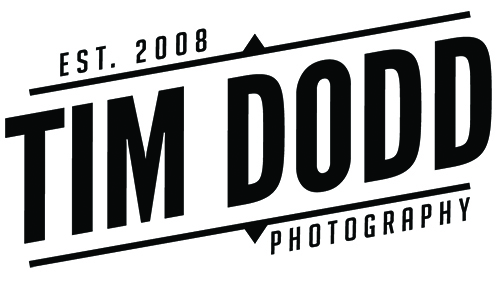


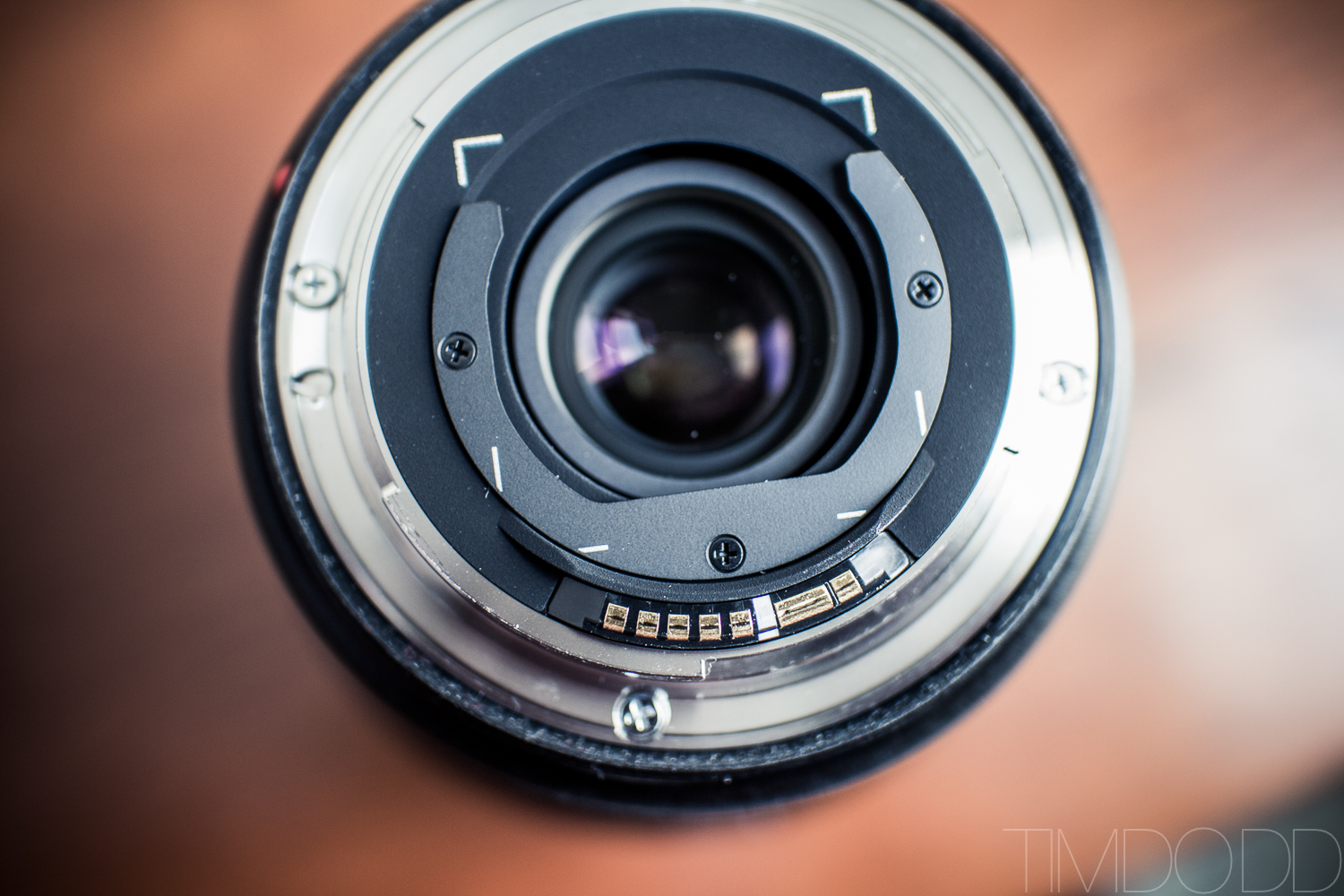
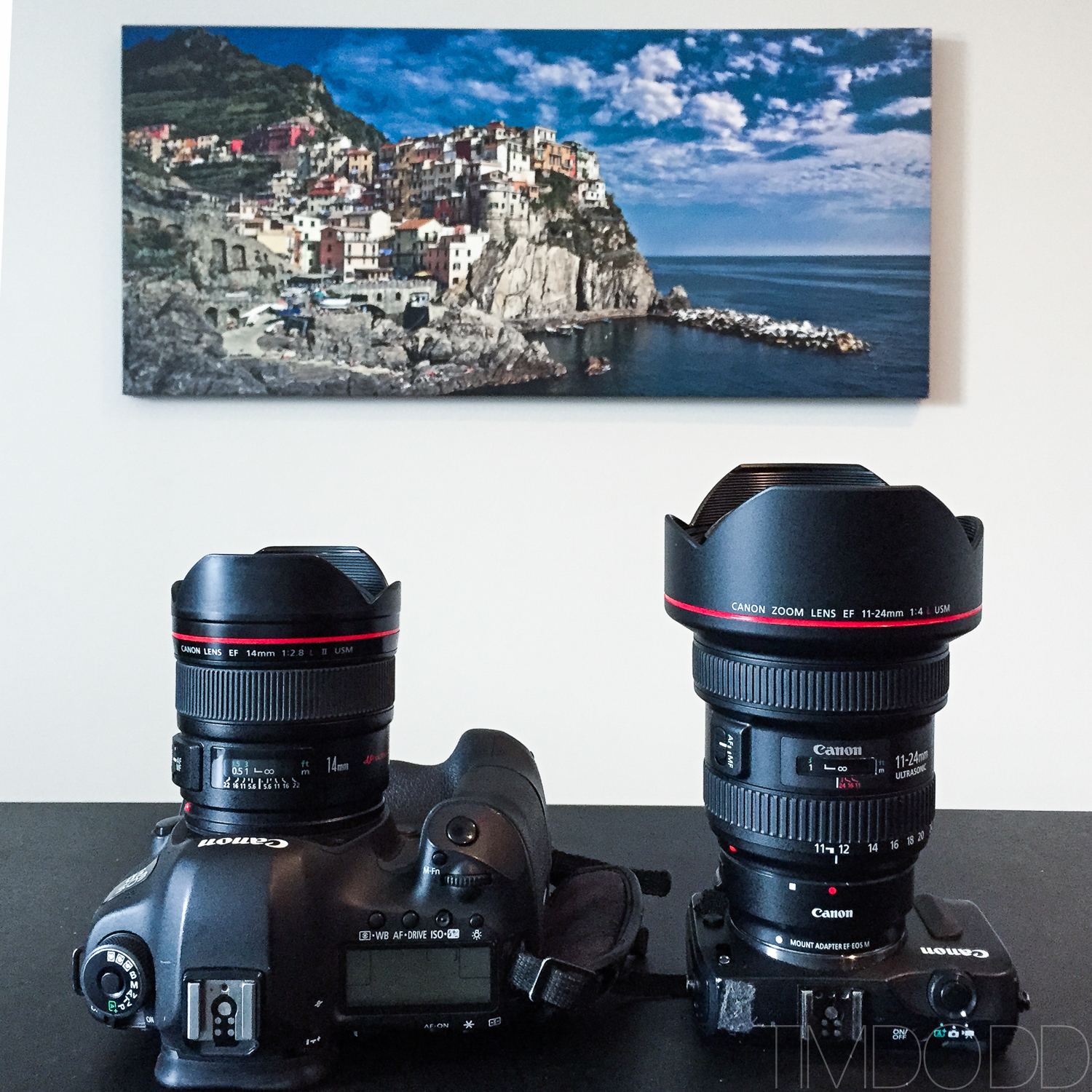
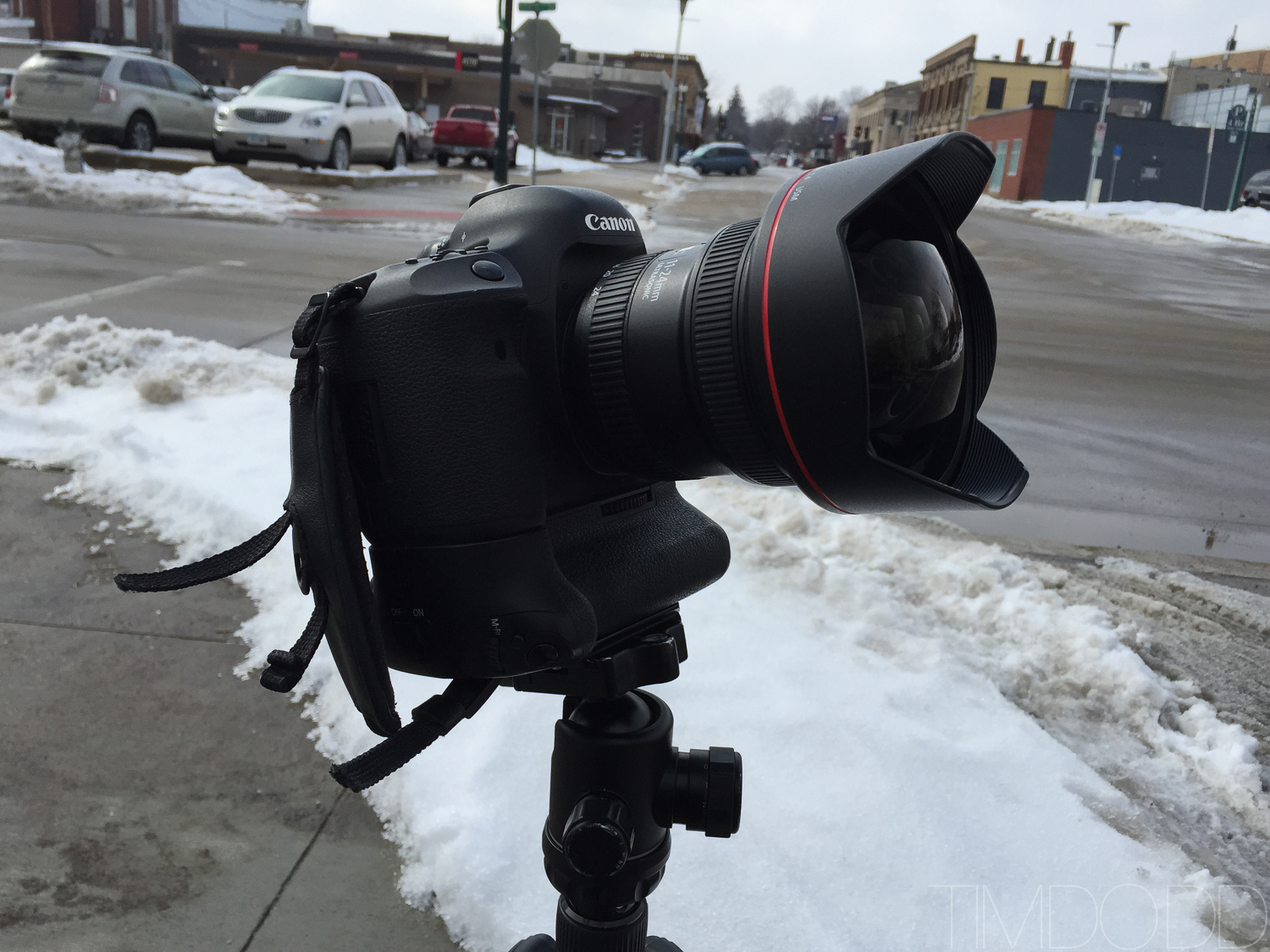
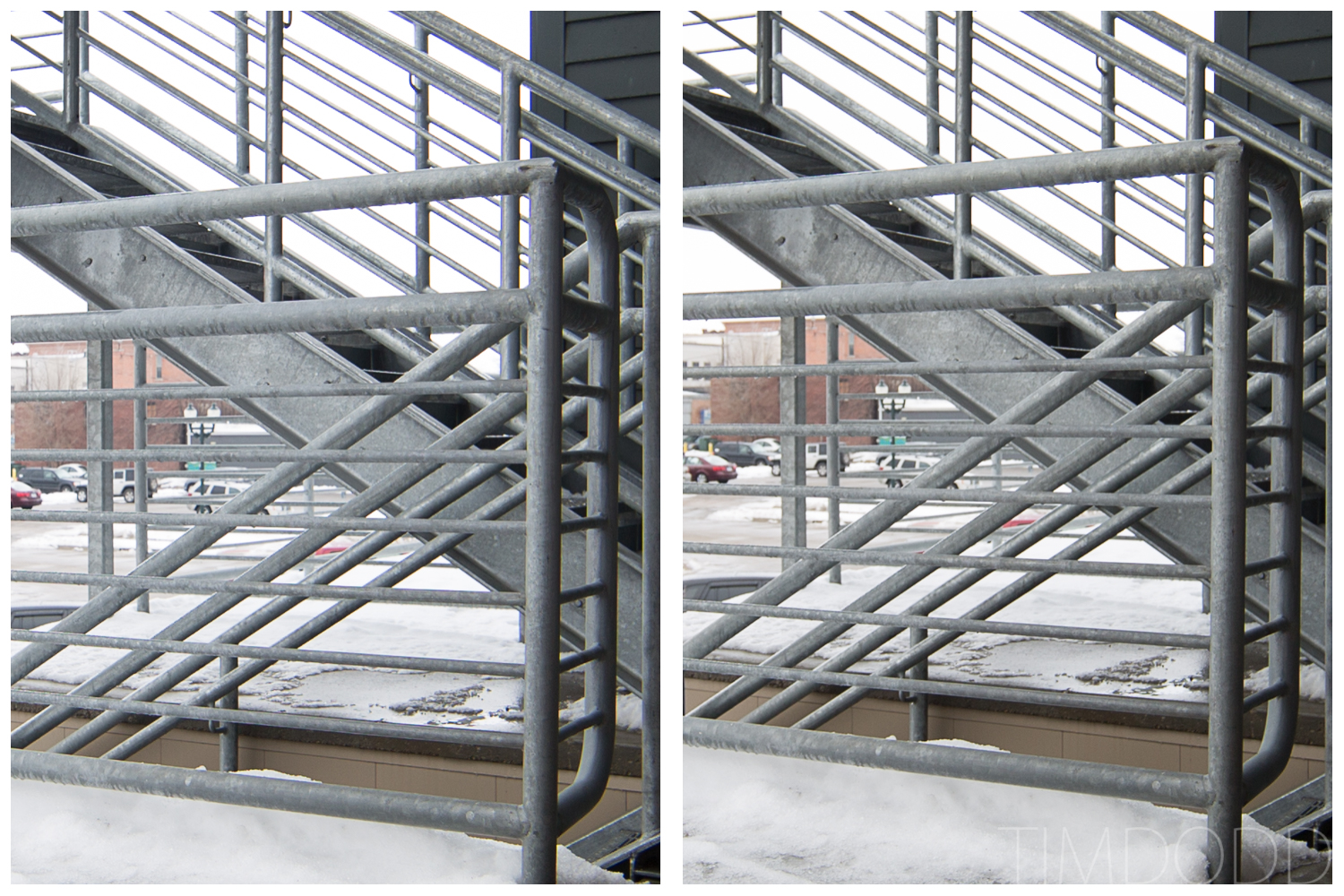
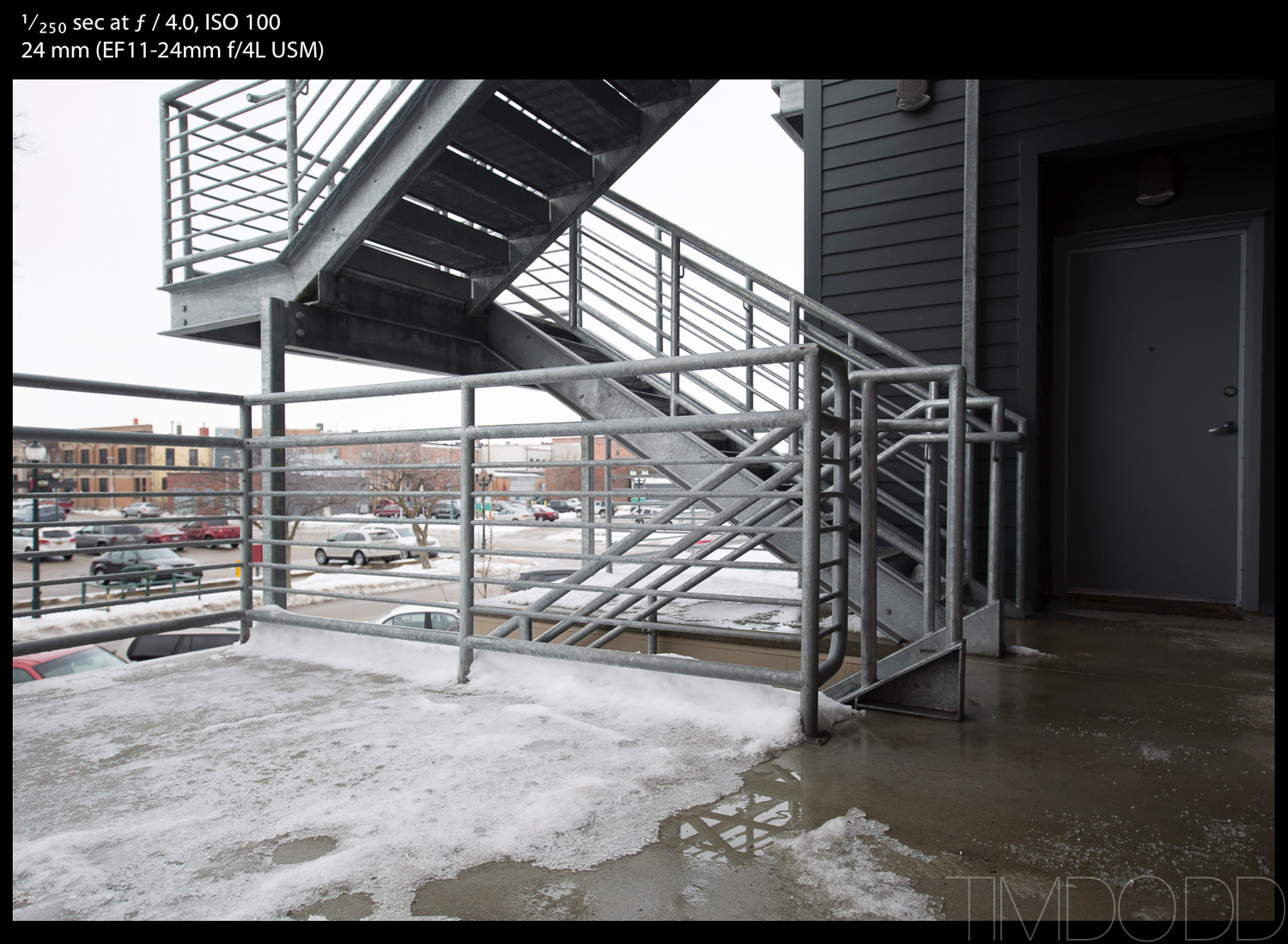
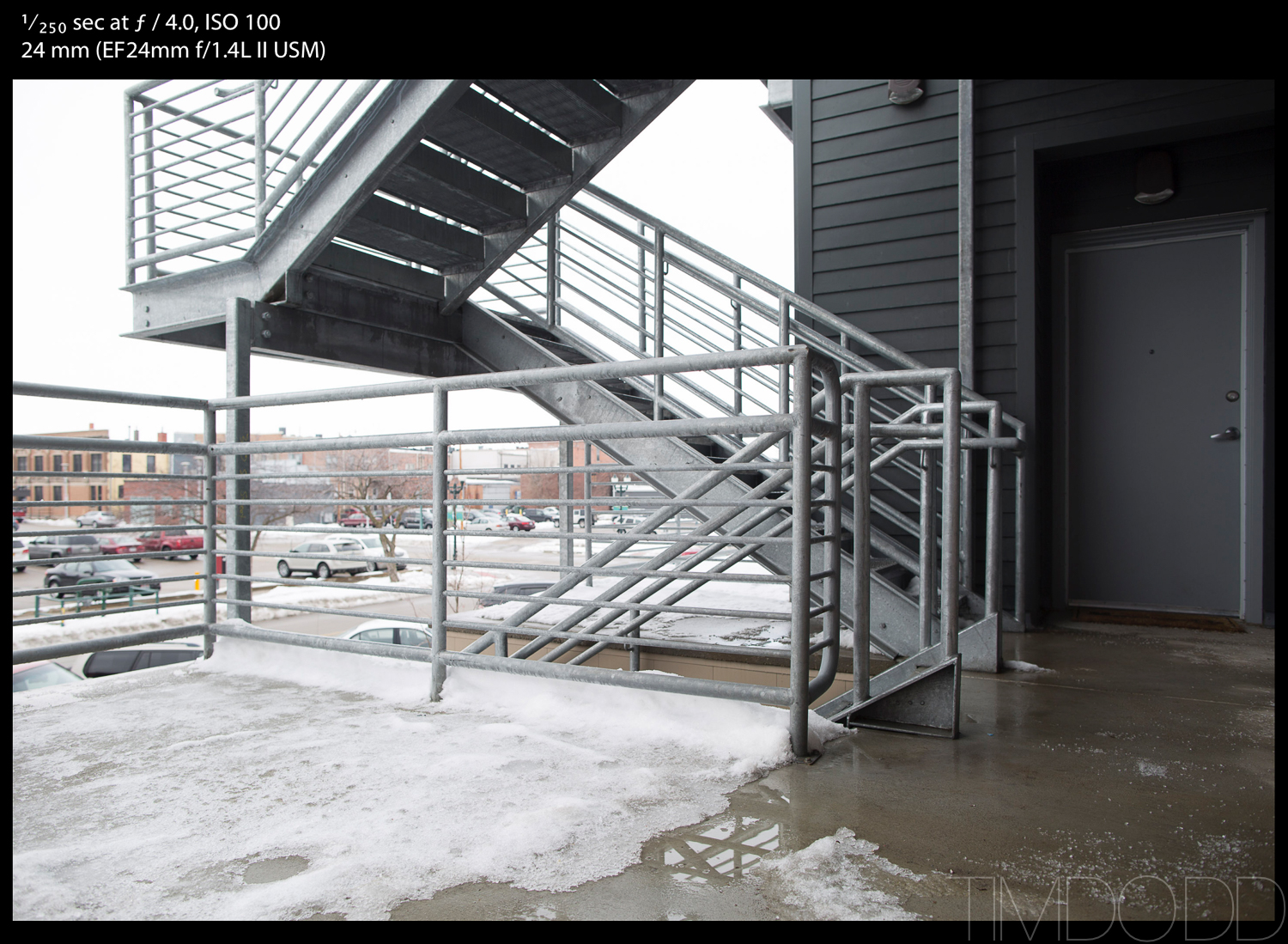
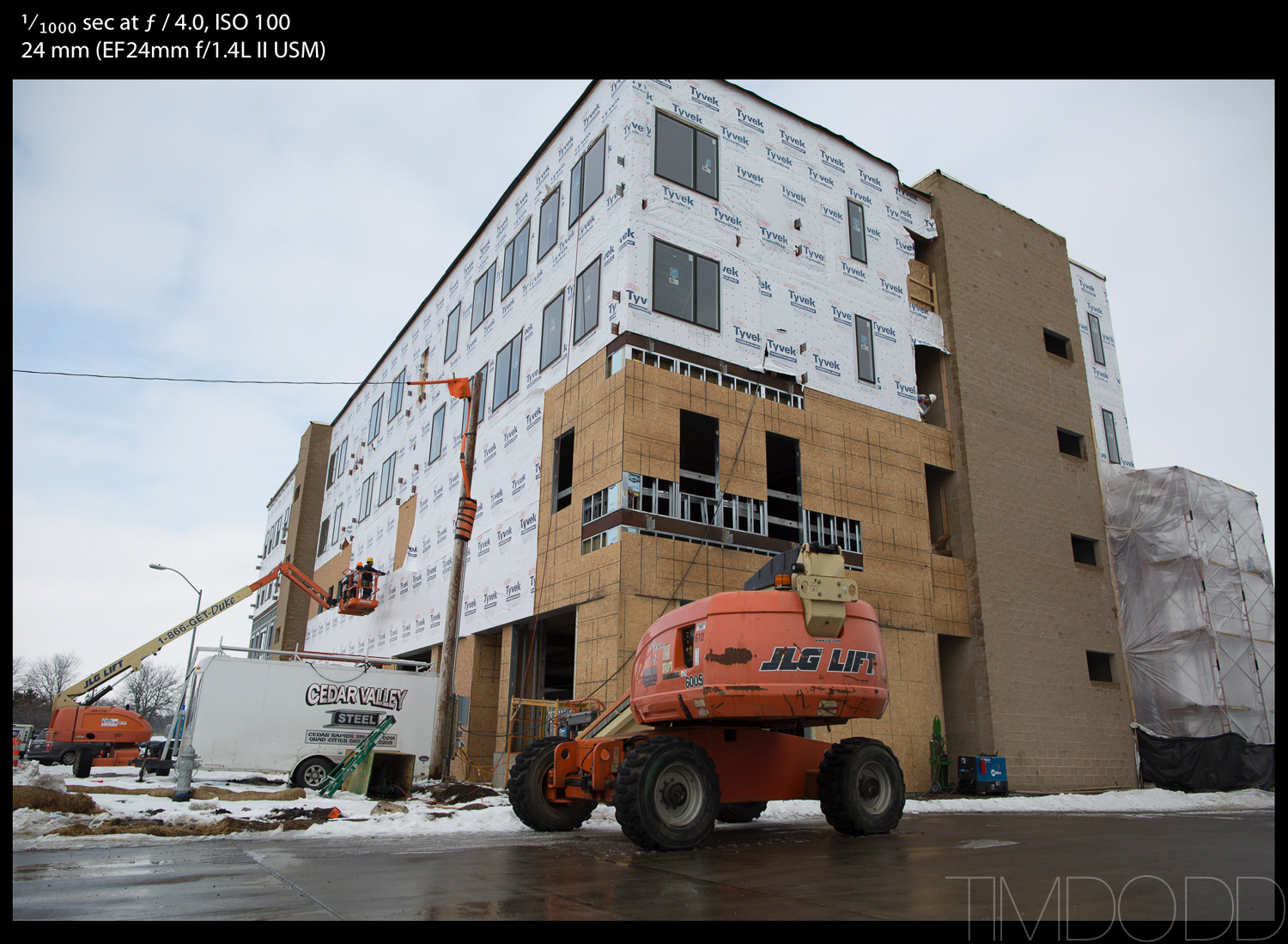
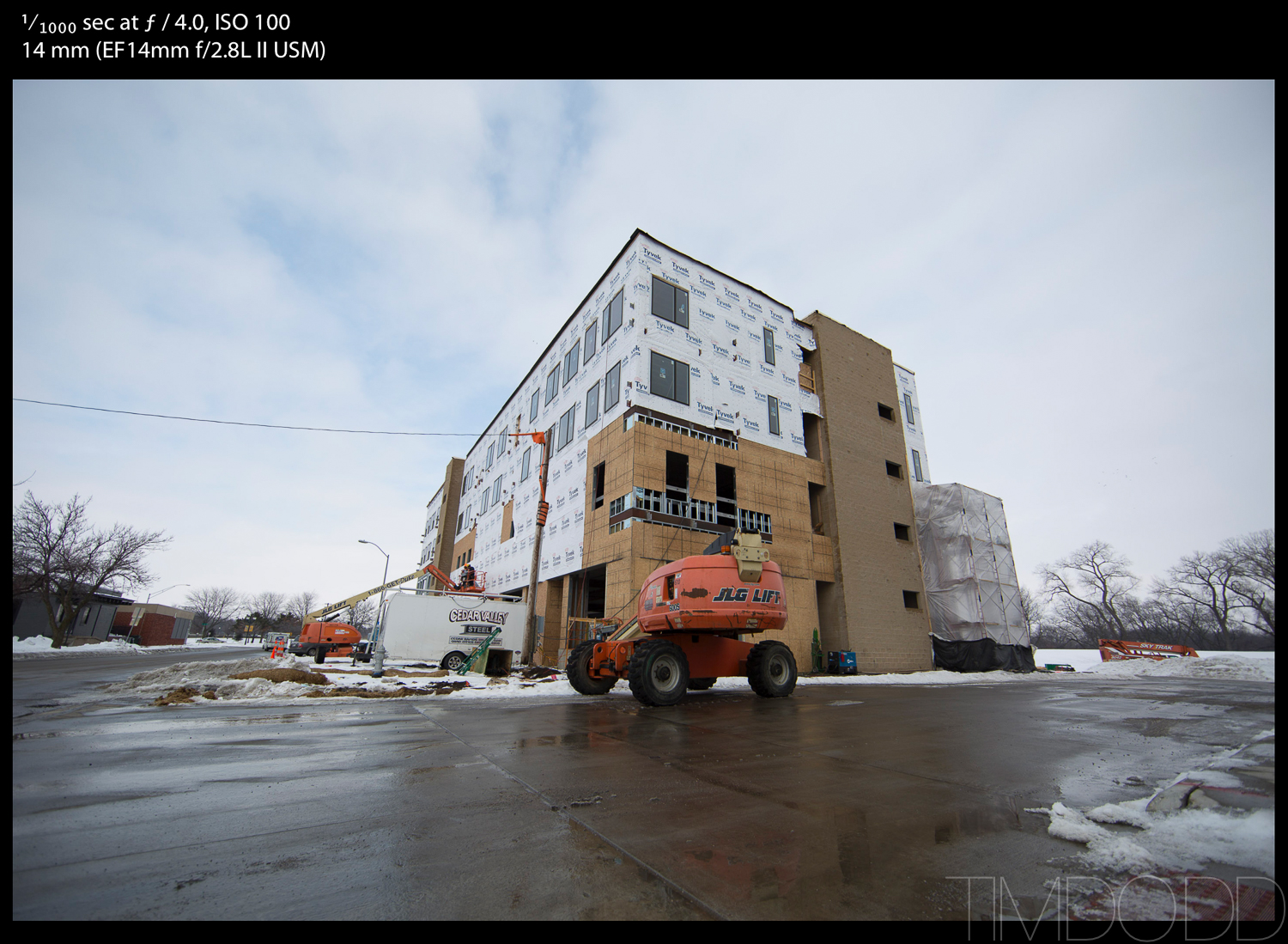
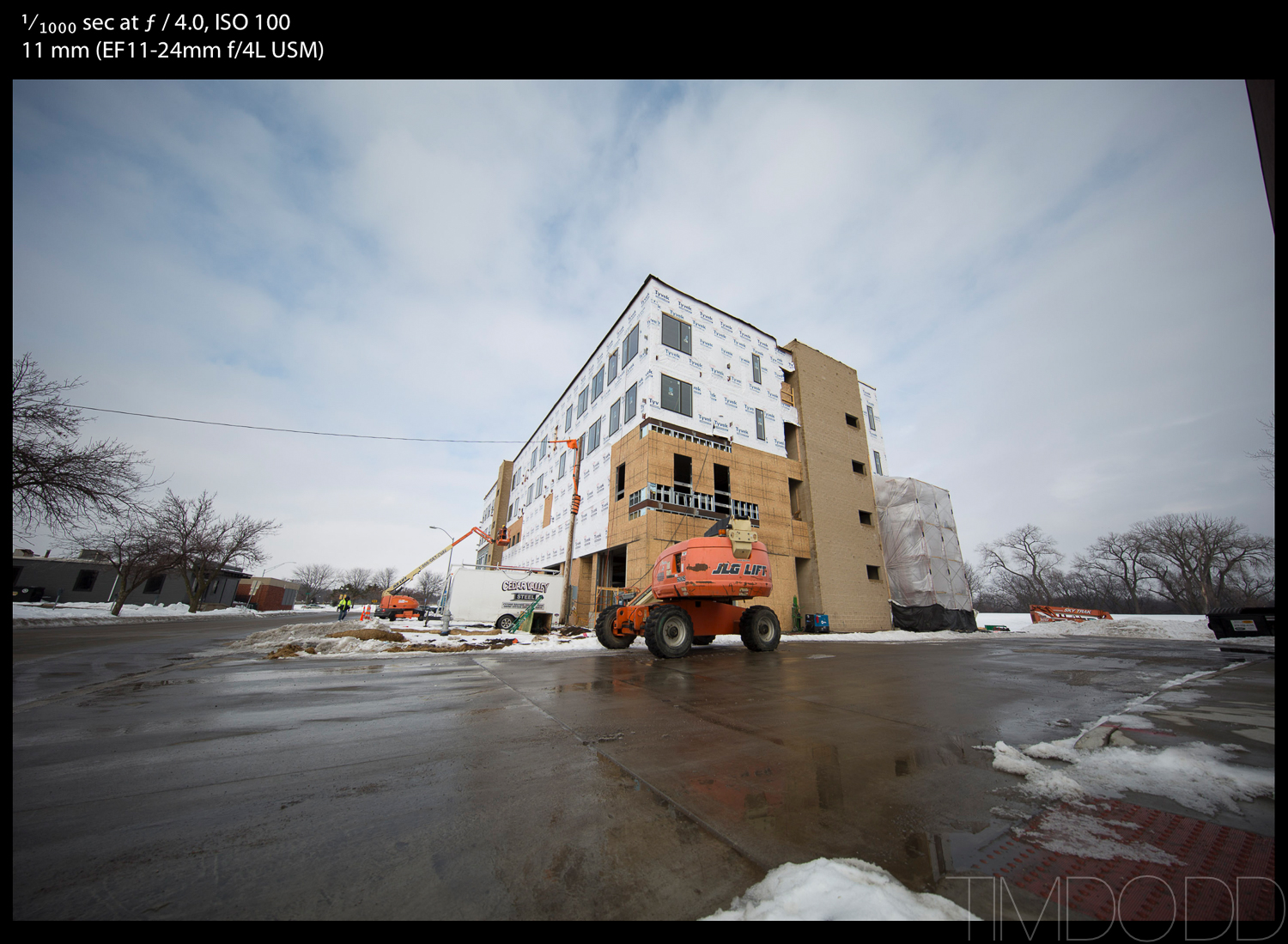
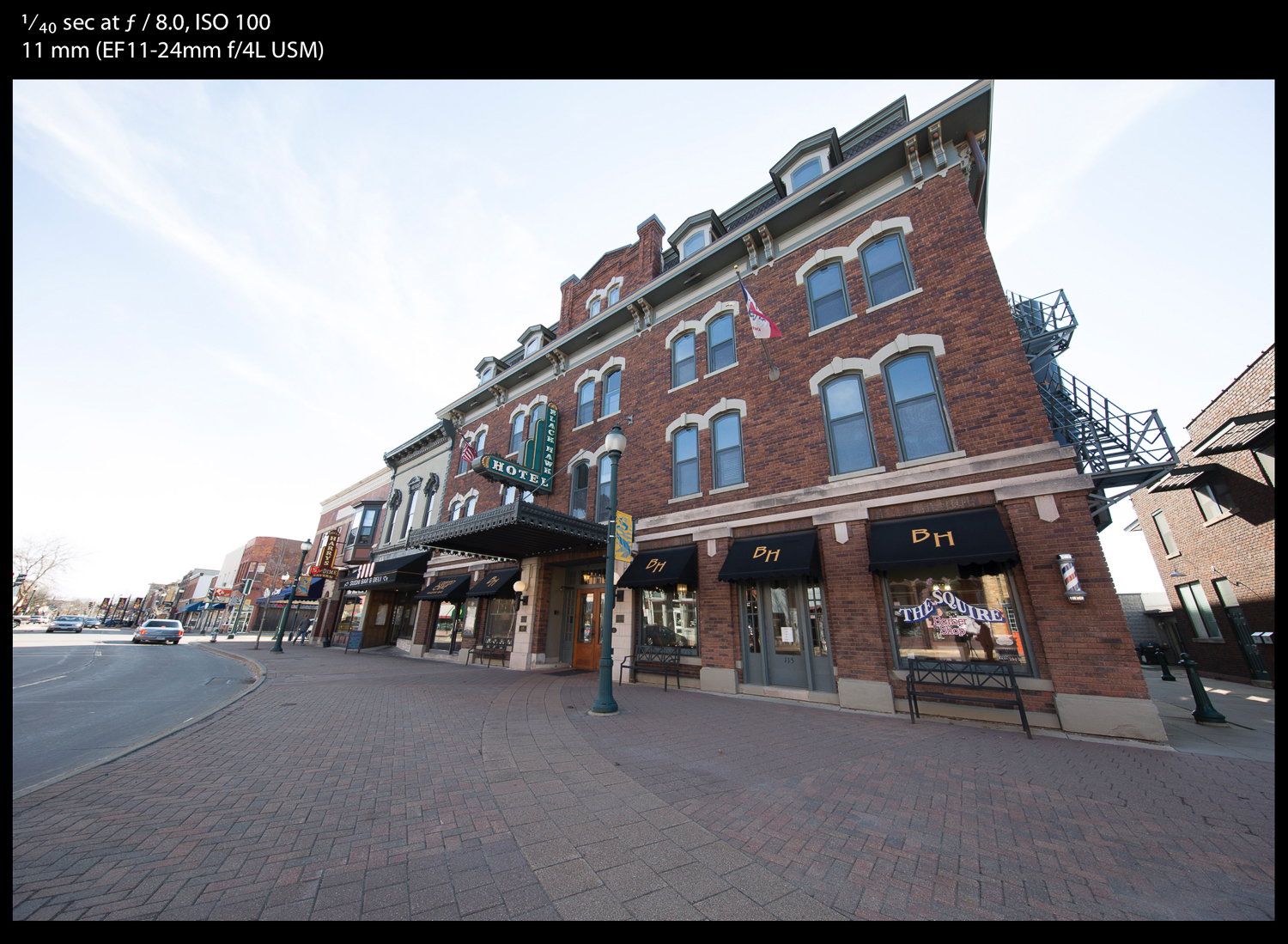
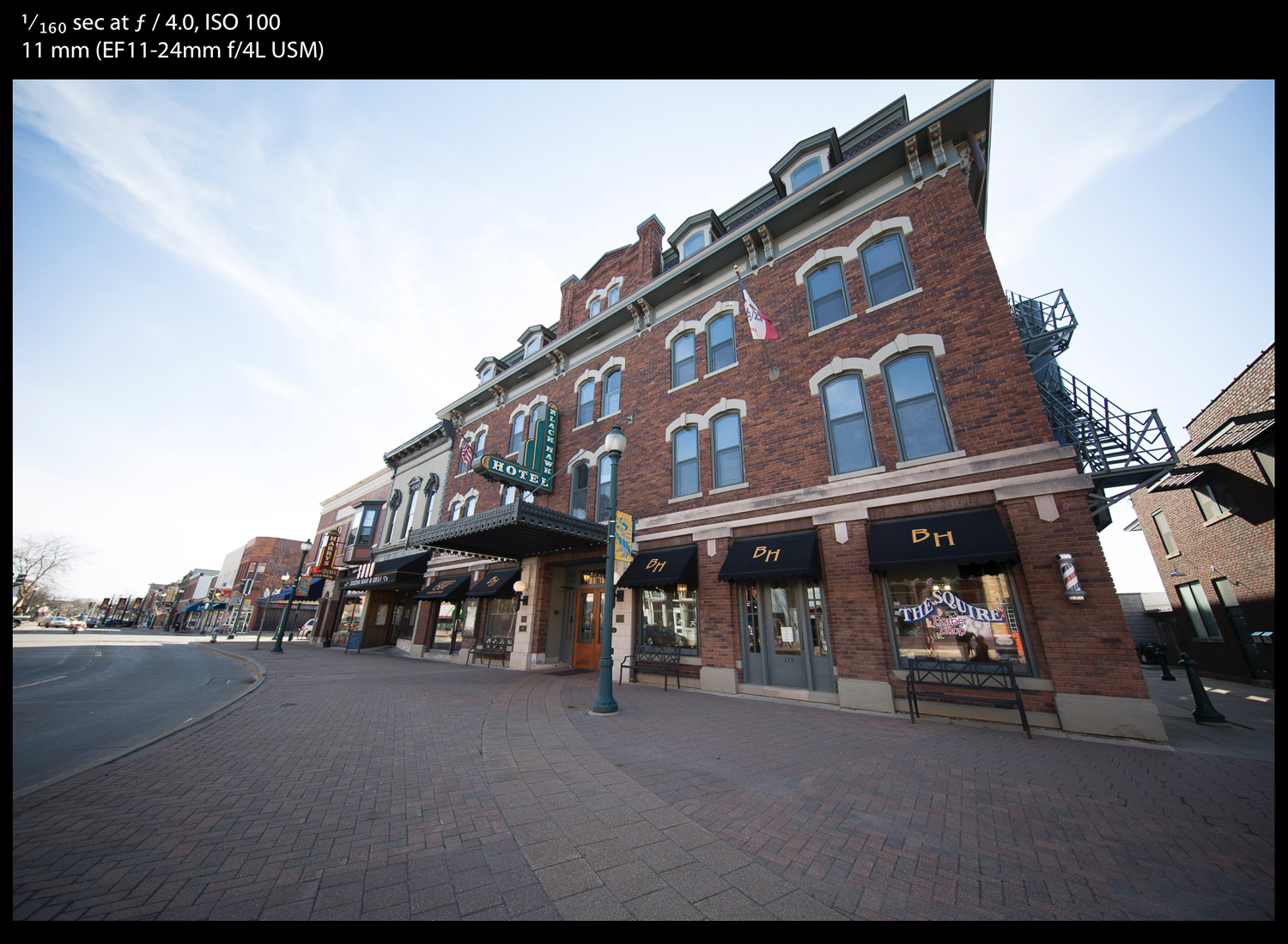










15 Comments
that soda can pic tho…unbelievable.
Thanks for the review Tim, but your comment about "square inverse law" to the best of my knowledge applies to light falloff based on distance to the source, not thru a change in f-stops. http://en.wikipedia.org/wiki/Inverse-square_law
a very decent review from a real world photographer
Barritt's Ginger Beer from Bermuda in Iowa. Awesome. Nice lens too :) I suspect for the photo enthusiast, going with this one (as opposed to two primes) is the better choice. Zoom range aside, how does it stack up against the 16-35 f2.8 or f4? Worth the extra dough?
Hey thanks for pointing this out John! I think the F-stop range is derived from light falloff, hence the 1, 1.4, 2 etc. Same ratio as light falloff…. I might be wrong, but I thought I read that once. If so, I'll change it :)
Hi, thanks a lot for sharing this!
I'd like to ask something that may sound weird: Does the 11-24mm f4L improves image sharpness CONSIDERABLY when stopping it down?
Or just a bit (as it happens with the new EF 16-35mm f4L IS that is even sharper wide open at some focals)?
Thank you very much!
On the 24mm F1.4L mk II comparison, are you shooting at F4 as my version is quite soft at f1.4
From what I can tell, the lens is pretty much out resolving my 22 MP sensor of the 5DMKIII at F4… It's a little soft in the corners. BUT, by F5.6 it appears to be crystal clear all the way through. Beyond what the MKIII can resolve.
Yes, at F4. You're right, I'm almost never go below F2.0 on the 24mm II, unless I have my back up against a wall… But F2.0 delivers excellent results
I've never actually shot with the 16-35 (any of them), so I can't directly compare. To me, since my primary goal was getting out as wide as possible, this was the best option for me. Optically, I'm not sure you'd need to shell out twice as much, as the 16-35 seems to be an excellent lens. So depending on your needs, I wouldn't necessarily recommend the 11-24 over the 16-35.
Thank you! :)
Tim Dodd They're similar concepts – but very unrelated! ;)
John MacLean Photography Oh shoot!!!! Let me correct that :)
John MacLean Photography Thanks for your help.
Here I was all excited for your review swaying my decision between the 11-24 and the 14mm 2.8L, with the 11-24 zoom winning out. Right up until the end when you said you do not shoot wide angle for landscape. I have been spending my time deliberating on which wide angle to add to my kit, already having the 24mm 1.4 but wanting to get wider on my night sky shots and also needing wider for real estate interiors. Both scenarios are just about always with a tripod so I have conceded to the F stop situation in my mind. And though I'm not so much in the hunt for a better landscape lens, (if I'm backcountry hiking I will usually choose to carry the 24-105 and the 24 1.4 for low light), I'm curious why this lens wouldn't make a top choice for landscape? Thanks in advance for your additional input.